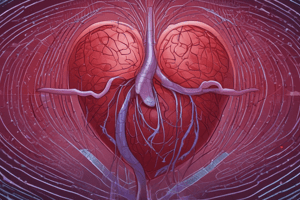Podcast
Questions and Answers
A patient with advanced heart failure experiences a drop in pulse pressure. Which of the following best explains this phenomenon, considering the relationship between pulse pressure and other hemodynamic parameters?
A patient with advanced heart failure experiences a drop in pulse pressure. Which of the following best explains this phenomenon, considering the relationship between pulse pressure and other hemodynamic parameters?
- Reduced stroke volume and potentially increased arterial stiffness. (correct)
- Decreased arterial compliance leading to increased pulse pressure.
- Elevated diastolic blood pressure maintaining pulse pressure.
- Increased stroke volume due to compensatory mechanisms.
During intense exercise, an athlete's stroke volume plateaus. What is the primary compensatory mechanism that maintains cardiac output at this stage?
During intense exercise, an athlete's stroke volume plateaus. What is the primary compensatory mechanism that maintains cardiac output at this stage?
- Decreased total peripheral resistance via vasodilation of skeletal muscle arterioles.
- Increased end-diastolic volume as a result of increased atrial contraction force.
- Increased venous return through enhanced muscle pump activity.
- Increased heart rate due to sympathetic nervous system activation. (correct)
A patient with a history of aortic regurgitation presents with increased pulse pressure. Which of the following physiological factors most directly contributes to this widened pulse pressure?
A patient with a history of aortic regurgitation presents with increased pulse pressure. Which of the following physiological factors most directly contributes to this widened pulse pressure?
- Increased total peripheral resistance elevates systolic blood pressure.
- Elevated end-systolic volume increases systolic blood pressure.
- Backflow of blood into the left ventricle reduces diastolic blood pressure. (correct)
- Increased arterial compliance reduces diastolic blood pressure.
In a patient experiencing ventricular tachycardia, the extremely high heart rate leads to a reduction in cardiac output. Which of the following factors is the most immediate cause of this decrease?
In a patient experiencing ventricular tachycardia, the extremely high heart rate leads to a reduction in cardiac output. Which of the following factors is the most immediate cause of this decrease?
A patient's echocardiogram shows an end-diastolic volume (EDV) of 150 mL and an end-systolic volume (ESV) of 75 mL. What is the ejection fraction (EF), and how should it be interpreted?
A patient's echocardiogram shows an end-diastolic volume (EDV) of 150 mL and an end-systolic volume (ESV) of 75 mL. What is the ejection fraction (EF), and how should it be interpreted?
A patient with obstructive sleep apnea (OSA) presents with elevated pulse pressure. What is the most likely underlying mechanism by which OSA contributes to this hemodynamic change?
A patient with obstructive sleep apnea (OSA) presents with elevated pulse pressure. What is the most likely underlying mechanism by which OSA contributes to this hemodynamic change?
According to the Fick principle, what happens to the Arterial O2 content – Venous O2 content difference when cardiac output decreases, assuming that the rate of O2 consumption remains constant?
According to the Fick principle, what happens to the Arterial O2 content – Venous O2 content difference when cardiac output decreases, assuming that the rate of O2 consumption remains constant?
A 70-year-old patient presents with isolated systolic hypertension. What age-related cardiovascular change is most directly responsible for the patient's increased pulse pressure?
A 70-year-old patient presents with isolated systolic hypertension. What age-related cardiovascular change is most directly responsible for the patient's increased pulse pressure?
In a patient with severe anemia, what compensatory mechanisms contribute to maintaining adequate mean arterial pressure (MAP), considering the relationship MAP = CO x TPR?
In a patient with severe anemia, what compensatory mechanisms contribute to maintaining adequate mean arterial pressure (MAP), considering the relationship MAP = CO x TPR?
A patient's mean arterial pressure (MAP) is measured at 80 mm Hg, and their diastolic blood pressure (DBP) is 70 mm Hg. Using the estimation formula MAP = DBP + ⅓ PP, calculate the patient's systolic blood pressure (SBP).
A patient's mean arterial pressure (MAP) is measured at 80 mm Hg, and their diastolic blood pressure (DBP) is 70 mm Hg. Using the estimation formula MAP = DBP + ⅓ PP, calculate the patient's systolic blood pressure (SBP).
Flashcards
Stroke Volume (SV)
Stroke Volume (SV)
Volume of blood pumped out of the heart per beat; calculated as end-diastolic volume (EDV) minus end-systolic volume (ESV).
Ejection Fraction (EF)
Ejection Fraction (EF)
Percentage of blood ejected from the ventricle with each contraction; calculated as (SV / EDV). Index of ventricular contractility; typically 50-70%.
Cardiac Output (CO)
Cardiac Output (CO)
Amount of blood pumped by the heart per minute; calculated as stroke volume (SV) multiplied by heart rate (HR).
Fick Principle
Fick Principle
Signup and view all the flashcards
Pulse Pressure (PP)
Pulse Pressure (PP)
Signup and view all the flashcards
Mean Arterial Pressure (MAP)
Mean Arterial Pressure (MAP)
Signup and view all the flashcards
Estimating MAP
Estimating MAP
Signup and view all the flashcards
Increased Pulse Pressure
Increased Pulse Pressure
Signup and view all the flashcards
Decreased Pulse Pressure
Decreased Pulse Pressure
Signup and view all the flashcards
Study Notes
Stroke Volume
- Stroke volume (SV) is determined by the difference between end-diastolic volume (EDV) and end-systolic volume (ESV): SV = EDV − ESV
Ejection Fraction
- Ejection fraction (EF) is calculated as stroke volume divided by end-diastolic volume: EF = (SV / EDV) = (EDV − ESV) / EDV
- EF serves as an indicator of ventricular contractility.
- EF is reduced in systolic heart failure.
- EF is usually normal in diastolic heart failure.
- Normal EF range is 50%–70%.
Cardiac Output
- Cardiac output (CO or Q̇) is the product of stroke volume (SV) and heart rate (HR): CO = SV × HR
- According to the Fick principle, CO can also be determined by: CO = (rate of O₂ consumption) ÷ (arterial O₂ content – venous O₂ content)
- During early exercise, both heart rate and stroke volume increase to maintain cardiac output.
- In later stages of exercise, cardiac output is sustained primarily by an increase in heart rate, as stroke volume plateaus.
- A very high heart rate, such as in ventricular tachycardia, reduces diastolic filling time, which leads to decreased stroke volume and cardiac output.
Pulse Pressure
- Pulse pressure (PP) is the difference between systolic blood pressure (SBP) and diastolic blood pressure (DBP):PP = SBP − DBP
- Pulse pressure is directly proportional to stroke volume.
- Pulse pressure is inversely proportional to arterial compliance.
- Pulse pressure is increased in conditions such as aortic regurgitation, aortic stiffening (isolated systolic hypertension in older adults), obstructive sleep apnea, high-output states (e.g., anemia, hyperthyroidism), and transiently during exercise.
- Pulse pressure is decreased in conditions such as aortic stenosis, cardiogenic shock, cardiac tamponade, and advanced heart failure.
Mean Arterial Pressure
- Mean arterial pressure (MAP) is the product of cardiac output (CO) and total peripheral resistance (TPR): MAP = CO × TPR
- At resting heart rate, MAP can be estimated as: MAP = DBP + ⅓ PP or MAP = (2/3 DBP) + (1/3 SBP)
Studying That Suits You
Use AI to generate personalized quizzes and flashcards to suit your learning preferences.




